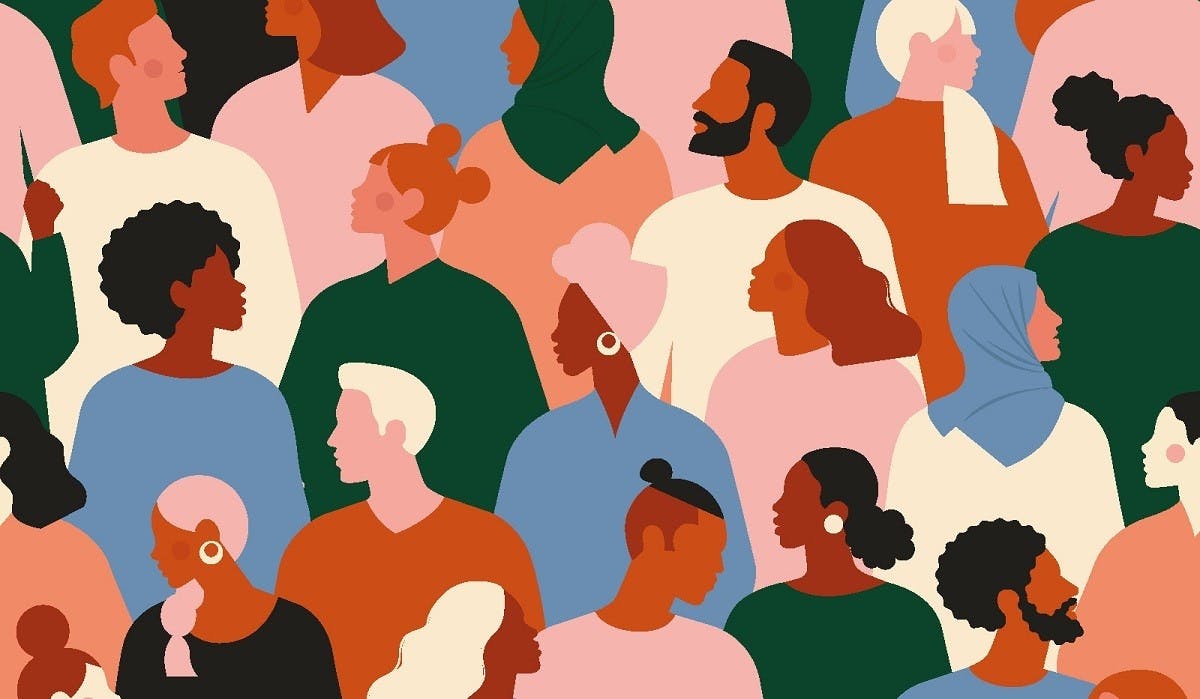Why is diversity hiring so controversial?
The latest controversy about diversity hiring revolves around conservative activists and legal challenges targeting diversity, equity, and inclusion (DEI) programs in corporations. This movement, often referred to as “woke capitalism,” has led to lawsuits and complaints against companies with diversity hiring programs, with some firms scaling back their efforts in response to the legal pressure. The Supreme Court’s affirmative action ruling has also raised concerns about legal uncertainty for businesses that promote diversity in their recruitment practices, potentially leading to a narrower talent pool for hiring, advancement, and leadership. Additionally, there are calls to reimagine inclusive hiring strategies, as some argue that diversity hiring was always flawed and in need of new approaches. Overall, the recent buzz about diversity hiring has sparked heightened scrutiny and legal challenges in the corporate sector. It is a topic that often rears its head in the halls of HR and most certainly in the recruitment sector.
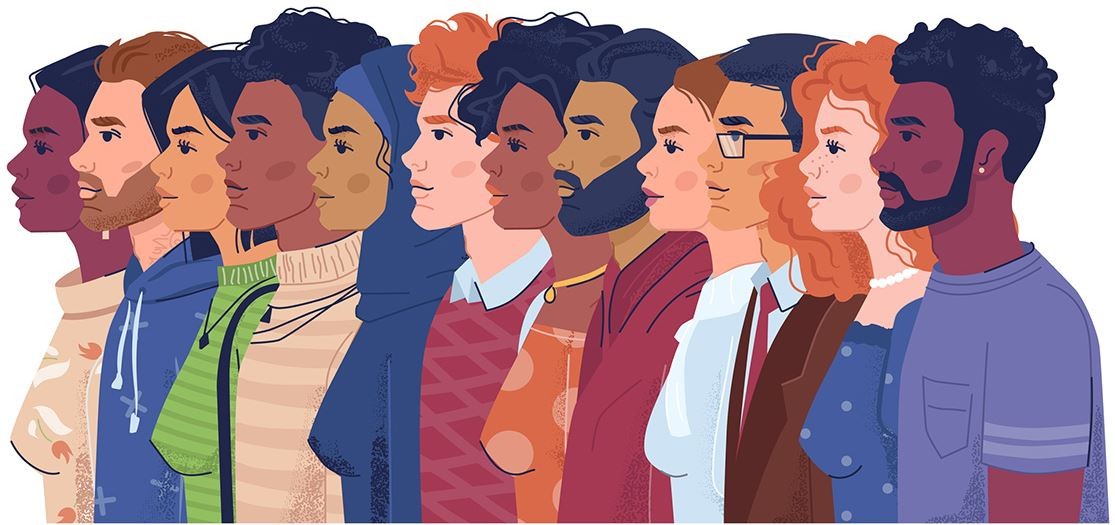
Back in my day, it was all about the Benjamins.
Politics and social unrest have sparked the buzz over the past few years but prior to that, the reason for diversity hiring was purely for bottomline benefit. (At least, that’s how I remember it.) Multiple studies have highlighted the positive impact of diversity and inclusion on workplace productivity, innovation, and profitability.
- A report from McKinsey & Company found that organizations in the top quartile for executive-level gender diversity were 25% more likely to have above-average profitability than those in the fourth quartile.
- World Economic Forum research revealed that companies with above-average diversity scores drive 45% average revenue from innovation, while those with below-average diversity scores drive only 26%.
- Research from Gartner indicated that through 2022, 75% of organizations with frontline decision-making teams reflecting a diverse and inclusive culture will exceed their financial targets.
- A study by Qlearsite showed that companies actively spearheading diversity and inclusion strategies are 35% more likely to achieve above-average returns, with business performance increased by 31%.
- The Wall Street Journal’s corporate ranking examined diversity and inclusion among S&P 500 companies, concluding that diverse and inclusive cultures provide companies with a competitive edge over their peers.
If for no other reason, diversity hiring is worth it because of this…
All that being said, I think the biggest benefit to diversity hiring is the presumed resistance to groupthink. ChatGPT defines groupthink this way…
Groupthink is a psychological phenomenon that occurs within a group of people in which the desire for harmony or conformity in the group results in an irrational or dysfunctional decision-making outcome. It is characterized by a tendency among group members to agree at all costs, leading to a consensus decision without critical evaluation. Groupthink can occur in various settings, including business, politics, and organizational environments. It often involves the suppression of dissenting opinions and the prioritization of group cohesion over objective analysis.
A few examples of how groupthink can negatively impact a company…
- Kodak, the former leader in camera technology maintained its stance that analog photography was superior to digital, refusing to adapt to the changing market. This resulted in the company ultimately filing for bankruptcy protection in 2012.
- Swissair, a Swiss airline company, became so powerful and financially stable that it earned the nickname “the Flying Bank.” However, the company’s board became overconfident, leading to a reduction in the number of board members and a loss of industrial expertise. This resulted in the company experiencing a pronounced financial collapse, prompting academic study and making it one of the most oft-cited examples of corporate groupthink.
- The American auto industry, including companies like Ford and General Motors, clung to the belief that big, powerful cars were what the market wanted, despite the successful competition from smaller, more fuel-efficient Japanese cars in the 1970s. This adherence to their own beliefs led to a loss of market share and exemplifies the impact of groupthink in a corporate setting.
- The 2008 Financial Crisis: The collapse of Lehman Brothers in 2008 is a prominent example of the impact of groupthink in the financial industry. A collective failure to critically evaluate the risks associated with subprime mortgage investments and the overall stability of the financial system resulted in a catastrophic financial crisis and global recession.
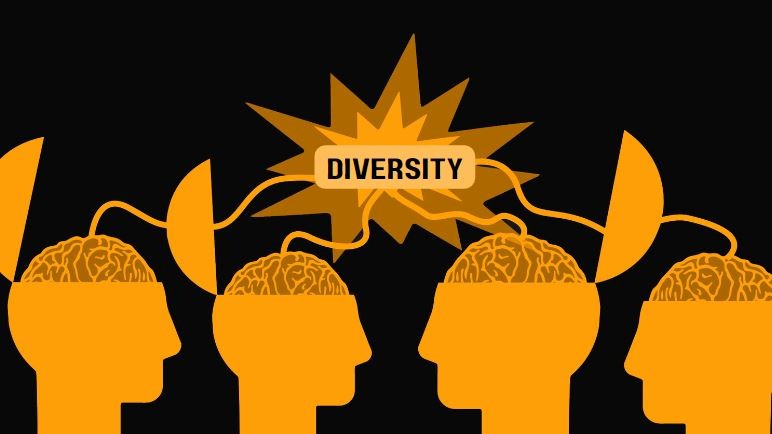
Is diversity just in your head?
Diversity hiring is not a guarantee against groupthink but it does stack the deck in favor of it, just as the arguably credible “diversity of thought” theory. A quote from CreativeHuddle addresses this…
Recent research by Heidrick & Struggles, published in HR Magazine, highlights the issue and shows that many businesses are aware of its relevance, demonstrating through the results of a large study that ‘diversity of thought’ is among the most important within a list of six aims among leading businesses. Based on a sample of more than 230 senior board members and data from the top 400 publicly listed companies across 15 European countries, the study identified six characteristics of dynamic governance each board should develop, with ‘diversity of thought’ named as highly important by participants. Some 97% of those surveyed said having the right balance of skills, knowledge and experience to constructively challenge senior management was important for board effectiveness.
Back in 2017, Apple’s vice president for diversity and inclusion, Denise Young Smith, made what some people believe to be a highly controversial statement. To quote Business Insider…
Speaking at the One Young World Summit in Colombia in October, Smith said, “There can be 12 white, blue-eyed, blond men in a room and they’re going to be diverse too because they’re going to bring a different life experience and life perspective to the conversation.”
She received immediate backlash for her comments, with many thinking her remarks were insensitive. Objectively speaking, I can understand and agree with her. Could a blue-eyed, blond man, who grew up Amish have a different perspective than a blue-eyed, blond man, who grew up in NYC? Yes, without a doubt. Politically speaking however, her comment was ill-timed. It was also highly debated in the tech sector as noted by a NY Times editorial. To quote…
But Ms. Smith wasn’t the first to endorse the view in her initial statement. Those of us in the tech industry know that the idea of “cognitive diversity” is gaining traction among leaders in our field. In too many cases, this means that, in the minds of those with influence over hiring, the concept of diversity is watered down and reinterpreted to encompass what Silicon Valley has never had a shortage of — individual white men, each with their unique thoughts and ideas. This shift creates a distraction from efforts to increase the race and gender diversity the tech industry is sorely lacking.
Further down in the article it reads…
As my former Facebook colleague Regina Dugan said recently, even if cognitive diversity is a company’s ultimate goal, “we can’t step away from the idea that diversity also looks like identity diversity.” The effort to hire people with different points of view must not come at the expense of hiring members of actual underrepresented communities who add tangible, bottom-line value — and who deserve to work in tech as much as anyone.

Diversity of Demographics vs Diversity of Thought
A diverse workforce encompasses differences in demographics, such as gender, race, ethnicity, and age, as well as differences in educational background, professional experience, and expertise. On the other hand, diversity of thought refers to the variety of perspectives, cognitive styles, problem-solving approaches, and decision-making processes that individuals bring to a team or organization. Which approach is better when both, at least in theory, will have a positive impact on the bottom line?
My thinking is that a forward-thinking company should have a recruitment strategy for both targets. Pursue underrepresented groups, encourage them to apply, while doing all you can to welcome them into the company culture. Likewise, do not turn away from sourcing different outlooks no matter outward appearances or sexual preferences. But how do you thread this needle? I have a few ideas.
How to Source for Diversity of Demographics
1. Target companies with Chief Diversity Officers
A Chief Diversity Officer (CDO) is a senior executive responsible for developing and implementing strategies to promote diversity, equity, and inclusion within an organization. The role of a CDO is to foster a workplace culture that values and respects differences among employees, including those related to race, gender, ethnicity, sexual orientation, age, disability, and other characteristics. If you target companies with CDOs then, it’s a good chance a diverse pool of talent is there as well due to the efforts of the CDO. But how do you find those companies? A cursory search on LinkedIn and Google returns dividends.
Here is a search for “Chief Diversity Officer” on LinkedIn. At this writing, 3,000 results.
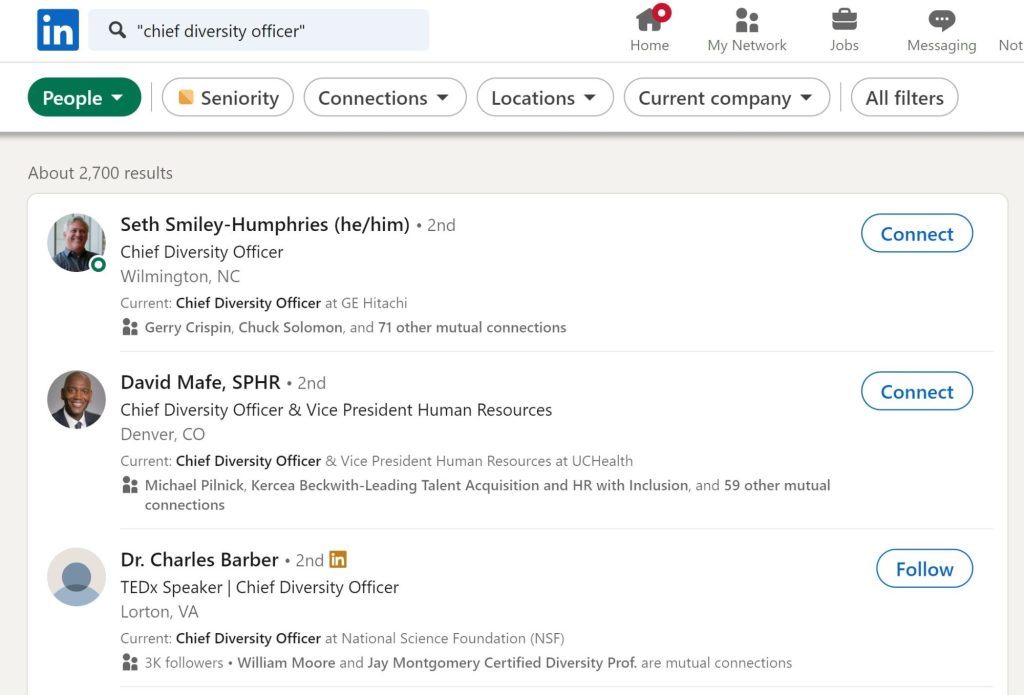
And I get several results searching Google for companies with chief diversity officers.

If you like this strategy, act fast, as this job title is on a downward trend.
2. Target companies with high diversity numbers.
Open Diversity Data is a project publicly sharing data on employee demographics at several companies. Its goal is to advocate diversity through data transparency. This is highly beneficial when plotting a sourcing strategy. For example, if a competitor – Company X, happens to have a sizable population of Hispanic workers, and you would like to build up that demographic among your ranks, then what better place to target your recruiting efforts? Just sayin’…
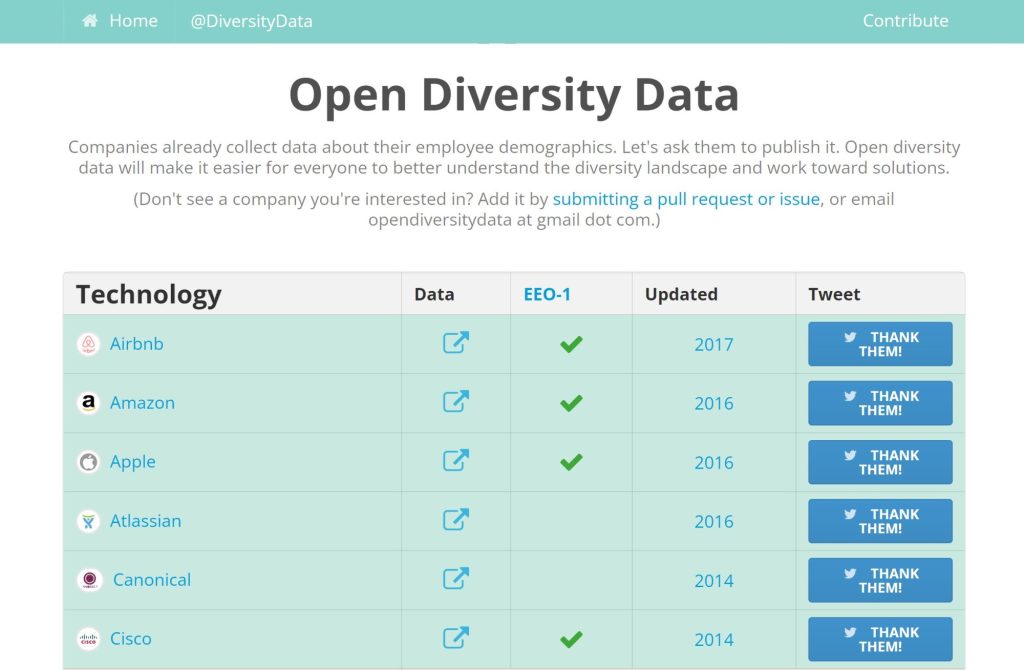
3. Target companies with an affinity for certain demographics
Are your numbers lacking in terms of disabled workers? Consider targeting companies that have been cited as the “best companies for disabled workers.” When I searched the search engine – Brave for best companies for disabled workers, I found results that cited Ernst and Young, Aetna, Cisco Systems and others. As a sourcer, focusing on those companies would increase the chances of finding disabled workers.
Other searches you may want to try when seeking other underrepresented groups:
4. Target companies recognized for their diversity efforts
When I search on “DEI awards,” several orgs recognizing the efforts and achievements of companies pushing the needle on diversity appear in the search results.
Among them…
- The 2023 ABA Diversity, Equity & Inclusion Awards
- National Diversity Awards
- Diversity, Equity and Inclusion Awards
5. Target Meetups
People use Meetup to meet new people, learn new things, find support, get out of their comfort zones, and pursue their passions, together. Networking these groups is a good option for finding specific demographics of people. Below are a few searches demonstrating that.
- deaf site:meetup.com
- deaf site:meetup.com boston
- hearing.impaired site:meetup.com boston
- (blind | low.vision) site:meetup.com
6. Target traditional gender and ethnic names
Search on traditional female names (like “Amy”), add a job title (like “software developer”) and you have (on LinkedIn) what appears to be 231 female developers named Amy.

Try the same search with other traditional female names to find more female developers. If you want to go deeper with this technique, try looking up baby names based on ethnic groups and searching LinkedIn based on that. For example, looking up data analysts named Akari may lead to a Japanese woman as Akari is a traditional Japanese female name.
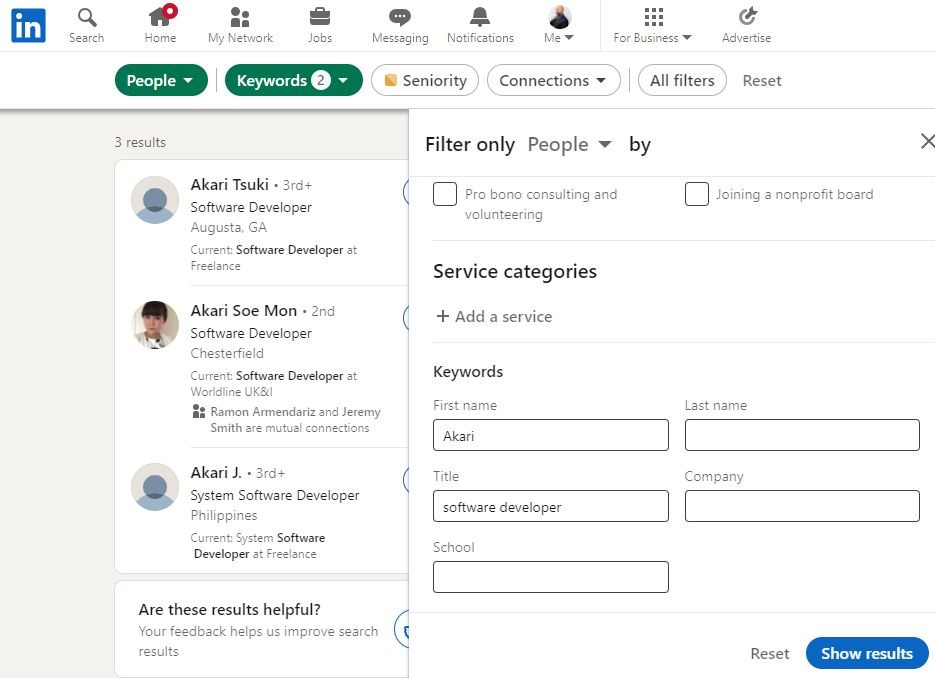
How to Source for Diversity of Thought
Personality driven job descriptions can be used to find candidates with diverse perspectives and even boost employee retention. I discussed how this happens, in the video below, when I used ChatGPT to write job descriptions based on Meyers-Briggs personality types.
In addition to personality-driven job descriptions, personality assessments can help identify candidates with a variety of personality types and attitudes, leading to a more diverse team. For example, “openness to experience” is positively associated with universal diverse orientation, which reflects an individual’s openness to different cultures and diversity. Individuals who are more extraverted are likely to have higher levels of Cultural Intelligence, which is essential for effectively navigating diverse cultural settings. Also, traits such as tolerance, modesty, and humility are connected to an individual’s ability to appreciate and respect different ways of thinking. Incorporating these assessments into the recruitment process would be beneficial. But I digress.

A Cult of Personality?
According to the Society for Industrial and Organizational Psychology, personality tests can be handy in the context of diversity, equity, and inclusion initiatives as well, despite the common misconception that they may homogenize the workforce. Research shows that personality assessment promotes fairness in selection and is a strong predictor of performance without producing meaningful subgroup differences, thereby preserving diversity in applicant pools. To quote…
For example, at Hogan we create selection profiles that are specific for each job, which significantly vary across an organization. Within a job, we typically only screen for a few personality characteristics and at extreme ends. For example, we might find that a role requires being conscientious and extraverted. We would screen out individuals who score extremely low on those characteristics; however, individuals in the role would still have varying scores on those characteristics above the screening threshold and even more variance on characteristics not in the profile.
Are you asking the right questions?
The approach of presenting candidates with scenarios that require ethical decision-making or consideration of diverse stakeholder interests can help find candidates with various viewpoints, for sure. By evaluating their thought process, how they analyze information, and the factors they consider in making decisions, employers can gain insights into candidates’ ability to navigate miscellaneous and complex situations. Sample interview questions in this vein are…
- Describe a time when you had to manage conflicting interests among stakeholders. How did you approach the situation, and what steps did you take to find a resolution?
- How do you ensure diverse perspectives are considered when making significant decisions? Can you share an example of a decision-making process where you actively sought out and incorporated various viewpoints?
- Sometimes, decisions may need to balance short-term goals with long-term considerations. Can you discuss a decision you made where you had to navigate this balance? What factors did you prioritize?
All that being said, the controversy surrounding diversity hiring reflects a mix of political and legal challenges, with conservative activists targeting corporations and legal uncertainties following Supreme Court rulings. (You can see this every day, if not most days, on the news.) Despite this, studies consistently emphasize the positive impact of diversity hiring on organizational success.
Diversity hiring, seen to combat groupthink and increase profitability, encompasses both demographic and thought diversity; or at least it should. Strategies for sourcing demographic diversity include targeting companies with Chief Diversity Officers, companies with high diversity numbers, and recognized diversity efforts. Whereas, cultivating diversity of thought includes using personality-driven job descriptions and assessments.
Contrary to conventional wisdom, research indicates that personality tests can contribute to fair selection without blending the workforce into a bland monolith. The key lies in asking insightful interview questions to gauge candidates’ abilities in navigating complex and diverse scenarios. Ultimately, a comprehensive approach to diversity sourcing, encompassing both demographics and thought, is crucial for building innovative and inclusive workplaces in today’s evolving DEI landscape. I’m keeping my fingers crossed that it will go mainstream.
